
Jerusalem, 1884 — Rosette Shapira must have felt an overwhelming sense of foreboding when three men, including the British consul to Jerusalem, arrived at the door of her home. After they entered, they sat opposite her and uttered those devastating words — her husband, Wilhelm Moses Shapira, was dead. He had killed himself with a gun in a rented guesthouse room near the Maas River wharf in Rotterdam, Netherlands, 2,000 miles away. Her life, and the lives of her daughters Augusta and Maria, would never be the same again.
Only days earlier, the office staff for the guesthouse began to wonder when they saw no sign of Moses leaving his room more than two days ago. A knock and shout from outside the locked door of his room yielded no sound. Soon, the police were at the door. Experiencing the same result, they broke into the room. What they found was everyone’s worst case scenario — Shapira was dead. He had apparently shot himself with a gun, leaving in the room his possessions, including a case that contained brochures, manuscripts, and letters. His body was taken and buried in an unmarked Rotterdam grave, far from his family home in Jerusalem. To this day, no one knows for certain where his body lies. It was a tragic and ignoble end to a life that mattered dearly to family and friends.
A Forgery
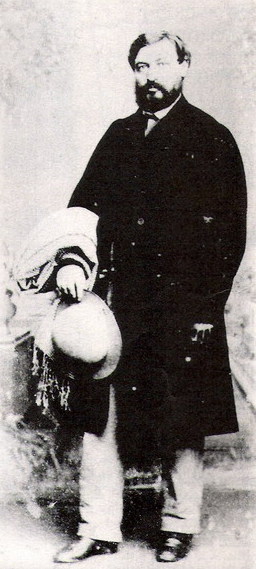 Moses (pictured left) Shapira’s journey to this tragic end actually began almost six years earlier, when he owned and managed what was considered to be “the best tourist shop in Jerusalem’s Old City” on Christian Street, not far from the historic Jaffa Gate. There, he sold books and a variety of other souvenir items popular to tourists. But his most passionate occupation was that of antiquities dealer, servicing, among other things, as a correspondent to the British Museum. Ancient manuscripts were his specialty, and over the years he had developed a body of knowledge and contacts that positioned him to be ‘in the right place at the right time’ when ancient artifacts and historic and ancient documents found their way into his sphere. His travels in the desert and elsewhere afforded him the opportunity to amass a significant collection of Arabic and Hebrew manuscripts, some of which he sold to the Royal Museum at Berlin, as well as to the British Museum. But none of his collections could possibly shine a light to what came his way in 1878, when Bedouins had discovered, in a cave high above the Wadi Mujib east of the Dead Sea, a bundle wrapped in linen. The bundle contained sixteen blackened leather strips, ranging from 3 to 4 inches in width, with varying lengths. The backside of the strips was coated with an asphalt/bitumin resin. But on the front side of the darkened strips, to Shapira’s astonishment, were barely legible written characters. Shapira knew enough to recognize it as a form of paleo-Hebrew. Knowing the relative antiquity of paleo-Hebrew script, could these be authentic documents, written by one or more unknown scribes, perhaps even well before Herodian times?
Moses (pictured left) Shapira’s journey to this tragic end actually began almost six years earlier, when he owned and managed what was considered to be “the best tourist shop in Jerusalem’s Old City” on Christian Street, not far from the historic Jaffa Gate. There, he sold books and a variety of other souvenir items popular to tourists. But his most passionate occupation was that of antiquities dealer, servicing, among other things, as a correspondent to the British Museum. Ancient manuscripts were his specialty, and over the years he had developed a body of knowledge and contacts that positioned him to be ‘in the right place at the right time’ when ancient artifacts and historic and ancient documents found their way into his sphere. His travels in the desert and elsewhere afforded him the opportunity to amass a significant collection of Arabic and Hebrew manuscripts, some of which he sold to the Royal Museum at Berlin, as well as to the British Museum. But none of his collections could possibly shine a light to what came his way in 1878, when Bedouins had discovered, in a cave high above the Wadi Mujib east of the Dead Sea, a bundle wrapped in linen. The bundle contained sixteen blackened leather strips, ranging from 3 to 4 inches in width, with varying lengths. The backside of the strips was coated with an asphalt/bitumin resin. But on the front side of the darkened strips, to Shapira’s astonishment, were barely legible written characters. Shapira knew enough to recognize it as a form of paleo-Hebrew. Knowing the relative antiquity of paleo-Hebrew script, could these be authentic documents, written by one or more unknown scribes, perhaps even well before Herodian times?
_______________________________
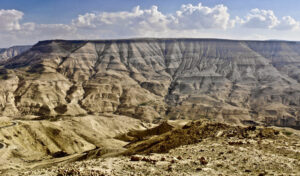
The Wadi Mujib, in Jordan. F.Higer, Creative Commons Attribution-Share Alike 3.0 Unported license. Wikimedia Commons
_______________________________
In his excitement he began to examine the strips on his own, preparing a transcription from whatever he could distinguish from leather surfaces that appeared to reflect the ravages of perhaps thousands of years. The strips appeared to document three incomplete manuscripts of a version of Deuteronomy, specifically the last speech of Moses to the Hebrews as they sojourned in the land of Moab, before his death. It contained a travelogue of the journey of the Hebrews in the wilderness, a somewhat different version of the Ten Commandments, and a series of blessings and cursings based on the commandments. One document was almost complete, another less complete, and a third represented only by a fragment. But he knew his initial transcription attempts would not be enough. The effort was a struggle. This was a job for an expert. In September, 1878, he sent his transcription to Konstantine Schlottman, a German scholar and friend, who in turn recruited the efforts of Franz Delitzsch, another German scholar. After examination, both strongly rejected the transcription as indicating the ancient documents had to be a forgery — the transcription, they maintained, deviated too radically from the traditional text of the Bible and what scholarship generally agreed was consistent with authentic scripture. Disappointed in Schlottmann and Delitzch’s determination, Shapira, still personally hopeful that the ancient strips were authentic, secured them away for a time in a vault at the Bergheim and Company Bank in Jerusalem and turned his attention back to other matters of his business.
………That is, until he got his hands on a book entitled Introduction to the Old Testament by another German scholar, Friedrich Bleek. The contents of the book convinced Shapira that the arguments that Schlottmann and Delitzsch used to refute his transcription could not be inarguably supported, and he decided to remove the strips from the vault and resurrect his efforts to seek scholarly examination and hopeful confirmation of the authenticity of the discovery. His strategy — to secure the services of other scholars in Germany and England, this time by bringing the actual documents, the strips, with him for their examination and study. If authenticated, his plan was to sell them to the British Museum for a handsome sum of, according to some newspaper accounts, as much as one million pounds, a value he felt well matched the value of the documents, which he hoped would bring financial independence to him and his family.
_______________________________

Lithograph of one of the Shapira Scroll fragments, Frederick Dangerfield for Christian David Ginsburg. Christian David Ginsburg, Public Domain
_______________________________
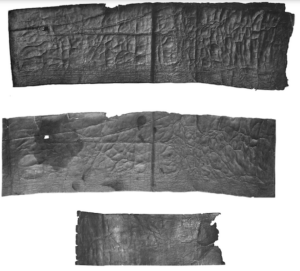
Two photographs of Shapira scroll ‘Fragment E’, columns 1–2, and one other fragment. In the top image, Fragment E is folded in half, with column 4 (verso) partially visible behind column 1 (recto). The image of the other fragment is cropped at the bottom. Idan Dershowitz, Creative Commons Attribution 4.0 International license, Wikimedia Commons
_______________________________
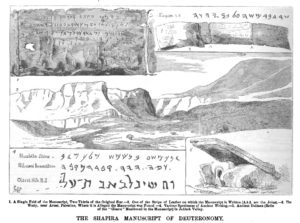
Shapira Strips, 1883, Scientific American. Scientific American, October 27, 1883, Public Domain
_______________________________
Examination resumed first with two German scholars, Hermann Guthe and Eduard Meyer, who carefully studied the strips and produced a transcript and evaluation. They leaned at first toward a determination of authenticity, but while they were finishing their work for publication, Karl Lepsius, head of the Royal Library at Berlin, convened another group of prominent scholars, consisting of professors Dillmann, Sachau, Schrader, Erman, and Steinschneider. Although these experts spent only a limited amount of time with the manuscripts, they quickly concluded that they were forgeries. They were impressed with them, however. They offered to purchase them, albeit at a lower price than Shapira was prepared to accept. These manuscripts, they maintained, were so cleverly forged they would be worth owning as an example of such outstanding effort.
Undaunted, Shapira went on to England, where, facilitated by Sir Walter Besant, secretary of the Palestine Exploration Fund, he secured the efforts of Christian David Ginsburg, one of the world’s leading authorities on Hebrew manuscripts. Ginsburg would spend weeks studying the manuscripts, including transcribing what he could successfully discern and decipher from the alleged ancient manuscript characters. Given the condition of the strips, the task was not easy. While he worked, regular updates of his progress were published in the Athenæum, a popular British literary magazine published in London at the time. While Ginsburg continued his examination, he expressed no clear opinion. That would wait for completion of his work. Some scholars, however, based mostly upon their reading of the continuing news and the reports in the Athenæum, expressed skepticism. Nonetheless, the excitement and news of Shapira’s manuscripts splashed across British newspaper venues. In addition, two fragments of the manuscripts were placed on display for the general public in the British Museum, drawing crowds. Even Prime Minister William Gladstone, who took a special interest in things biblical and the scholarly work of Ginsburg, visited the display and engaged in personal conversation with Ginsburg and Shapira about the manuscripts. It seemed, finally, Shapira’s manuscripts were gaining the positive traction he so longingly desired — at least from the public.
__________________________________
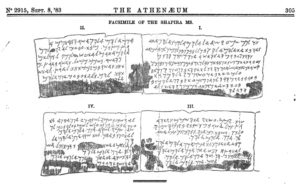
Facsimile of some of the Shapira scroll, as published in The Athenaeum, September 8, 1883, after Ginsburg. Ginsburg, Wikimedia Commons, Public Domain
__________________________________
The Crash
But the new high Shapira was experiencing would not last long. Charles Clermont-Ganneau, a world-renowned French orientalist and archaeologist, heard news of the leather strips coming out of England. He was known for his skill in detecting forgeries, and was in fact instrumental in debunking ancient Moabite pottery artifacts years before, an affair in which Shapira himself was deeply involved as a dealer. Clermont-Ganneau, even from afar, already harbored suspicions about the authenticity of Shapira’s leather strips, and wanted to see them for himself. With a mandate from the French minister of public instruction, he was sent on his way to England to examine for himself what the British hype was all about. On arrival, he was given access to view and study fragments of the strips, but under very limited access and time constraints, while Ginsburg continued with his more in-depth examination.
Even with the limitations, however, it did not take long for Clermont-Ganneau to come to his conclusions. Though he was expressly permitted to publicize his finding only after Ginsburg had a chance to publish his report, Clermont-Ganneau forged ahead prematurely and announced his thoughts to the press: The manuscripts were forgeries.
Although he noted various reasons supporting his conclusion, his most cited argument was that someone, perhaps Shapira himself, had cut off the bottom blank margin of an old Torah scroll, perhaps several centuries old, creating strips upon which he (or someone) inscribed characters very much like those found on the Moabite stone and Siloam Inscription. Moreover, shortly following Clermont-Ganneau’s pronouncement, Ginsburg published his report. He agreed with Clermont-Ganneau. The manuscripts were forgeries. The scholarly consensus fell in favor of the forgery assessment.
For Shapira, it was like his world had come crashing down. With this news out to the world, he must have thought he was ruined, branded perhaps forever as a forger. Even so, still clinging to his conviction that the inscribed leather strips were authentic, he left the manuscripts behind at the British Museum and traveled on to other points in Europe. He continued with some business dealings, but ended up ultimately in Rotterdam in early March, 1884, where he presumably took his own life in a guesthouse room near the Maas River.
____________________________
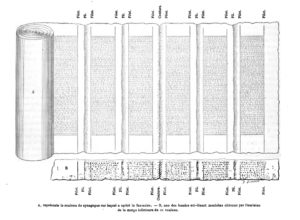
Illustration used by Clermont-Ganneau to demonstrate the cutting of the Torah scroll to create the Shapira strips. Clermont-Ganneau, Wikimedia Commons, Public Domain
____________________________
A Forgery? The Case for Re-examination
Scrolls in the Desert
New discoveries can often shift the ground upon which prevailing scholarship stands. One could argue that this is what happened when, between November 1946 and February 1947, Bedouin shepherds discovered seven ancient scrolls/fragments contained in ceramic jars in caves near the ancient site of Khirbet Qumran, 1.5 miles from the northwestern shore of the Dead Sea. Known today in the popular literature as the Dead Sea Scrolls, they were the first of subsequent ancient scroll and fragment discoveries in the Dead Sea area, attesting to the continuing ancient Hebrew practice of documenting sacred texts containing beliefs and histories on leather parchment and papyrus — and, given the dating of the finds, that such material could actually survive at least 2,000 years in the Dead Sea area.
This is important for these purposes because one of the salient early arguments among the 19th century scholars against the authenticity of Shapira’s manuscripts was that leather documents were unlikely to survive for 2,000 or more years in the environment in which they were allegedly found — in this case, caves above the Wadi Mujib, not far east from the Dead Sea.
What is more, the Shapira manuscript strips were alleged to have been found wrapped in cloth and treated on the exterior with a pitch/asphalt/wax/bitumin resin coating, not unlike the state and treatment of at least some of the Dead Sea Scrolls found, here again, by Bedouin shepherds in a high desert cave not far from the Dead Sea. Could it be that, as a clever forger, Shapira simply possessed an uncanny, almost “prophetic” sense for fabricating circumstances so serendipitously similar to those characterizing the discovery of the Dead Sea Scrolls, a series of events that occurred more than 65 years later? Some noted scholars have suggested that this would not have been probable.
Menahem Mansoor, Professor Emeritus of Hebrew and Semitic Studies at the University of Wisconsin-Madison, wrote about the circumstances, and much more, related to the Shapira manuscripts: “Neither the internal nor the external evidence, so far as yet published, supports the idea of a forgery.”* His assessment was published in 1958, after the discovery of the Dead Sea Scrolls. Add to this the comments made by John Allegro, one member of the initial select team of scholars assigned to work on the Dead Sea Scrolls, wherein he stated that the Shapira manuscripts “may have been one of the most important archaeological findings of all time”.** Though Allegro’s scholarship and reputation were certainly not without controversy, it goes without saying that the Dead Sea Scrolls clearly had an impact on how he viewed the Shapira scrolls in 1965, when his book, The Shapira Affair, was published.
_____________________________
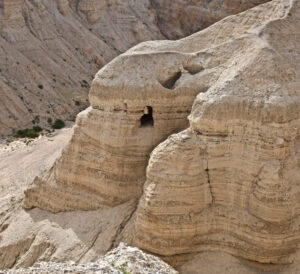
View of the caves location near Qumran, where many of the Dead Sea Scrolls were discovered.
_____________________________
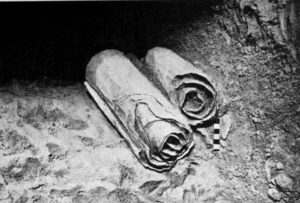
Two scrolls from the Dead Sea Scrolls lie at their location in the Qumran Caves before being removed for scholarly examination by archaeologists. Abraham Meir Habermann, 1901–1980, Wikimedia Commons, Public Domain
_____________________________
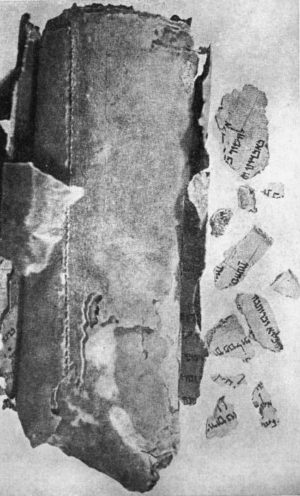
One of the original Dead Sea Scrolls before being unraveled by scholars. Abraham Meir Habermann, 1901-1980, Wikimedia Commons, Public Domain
_____________________________
Add to this another prominent charge levied by scholars, led first and foremost by Clermont-Ganneau himself upon completing his initial cursory examination of the Shapira strips — in short, that Shapira’s leather strips were actually cut from the bottom blank margin of a Torah scroll and then used as the support medium upon which the paleo-Hebrew characters were written, or forged. The subject scroll may have eventually ended up in the Sutro Library in San Francisco, where today rests a Torah scroll that has been clearly intentionally cut off at its bottom margin. This, says investigative journalist Chanan Tigay in his recent book, The Lost Book of Moses, could be a candidate for the scroll. However, Idan Dershowitz, who is currently Chair of Hebrew Bible and Its Exegesis at the University of Potsdam and Faculty Member at Harvard University, has now suggested in a recent paper, The Valediction of Moses: New Evidence on the Shapira Deuteronomy Fragments, that the Torah scroll could as likely have been cut along the top edge of the bottom margin to remove clearly evident extensive water damage that effected the bottom of the scroll. Nonetheless, the cut Torah scroll argument has remained one of the pillars upon which scholars have rested their verdict for more than a century.
Enter here also the Dead Sea Leviticus scroll 11QpaleoLev, a leather parchment scroll which, like the Shapira scroll, was inscribed in paleo-Hebrew. It was discovered in “Qumran Cave 11,” about one mile north of Khirbet Qumran in January of 1956 by local Bedouin of the Taʿamireh clan. This scroll spreads lengthwise in an arc-like fashion. In like manner, the Shapira leather strips, also allegedly found by local Bedouins in a cave not far from the Dead Sea, spread lengthwise in an arc — not a characteristic that would likely be attributed to leather strips that were fraudulently cut from the bottom margin of a Torah scroll, which exhibits no such curvature.***
______________________________
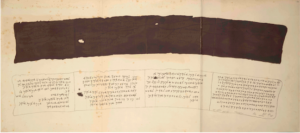
Fragment E, prepared by Dangerfield Lithography (London, 1883), in consultation with Ginsburg. From Dershowitz, Idan (2021). The Valediction of Moses: A Proto-Biblical Book. Forschungen zum Alten Testament. Idan Dershowitz, Creative Commons Attribution 4.0 International license, Wikimedia Commons
______________________________
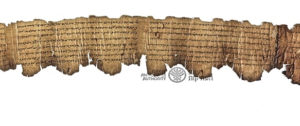
The paleo-Hebrew Leviticus scroll (11QpaleoLev), discovered in Cave 11 near Qumran. [Like the Paleo-Hebrew Shapira scroll, also made of leather and in an arc-like shape.] Shai Halevi on behalf of the Israel Antiquities Authority (IAA). Creative Commons Attribution-Share Alike 4.0 International license, Wikimedia Commons
Script and Content
A major line of reasoning for characterizing the Shapira manuscripts as forgeries revolves around the script and subject matter content. To this day, there are prominent scholars of the field who continue to maintain rejection based on these grounds. One notable example is André Lemaire, a well-known and highly regarded French epigrapher, historian and philologist, who has voiced his support for the results of, among other things, Ginsburg’s examination regarding the external and internal (language, paleography and grammar) criteria cited to justify rejection of Shapira’s strips. Lemaire’s argument, however, is based on his examination of Ginsburg’s facsimile of the original manuscripts, not the original strips themselves. Idan Dershowitz has now suggested in his recent paper (noted above) that Lemair’s argument falls flat on the basis of “a fundamental methodological problem with the entire enterprise of epigraphic analysis in this particular case: The fragments are no longer extant.” In his paper, Dershowitz argues in detail why Lemaire’s analysis is faulty in that it relies on 19th century drawings, not the original manuscripts, that are “demonstrably unreliable” for accurately depicting the paleography of the manuscripts.****
Another chief argument among scholars against the authenticity of the Shapira manuscripts revolved around how radically the content of the account departed from the Masoretic text and the generally accepted canon of Deuteronomy. Scholarly tradition holds that the original ‘writings of Moses’ that constituted the core of Deuteronomy were later supplemented/changed in antiquity (for example, the Deuteronomic law codes) to create what is today the accepted canon of Deuteronomy. Others, like Jonathan Klawans, Professor of Religion at Boston University most recently, have argued that the manuscript content reflects Shapira’s Jewish-Christian beliefs and thus a ‘Christianizing tendency’ in its fabrication. Dershowitz, however, presents a starkly different view based on his extensive study and analysis as related in his recent monograph, The Valediction of Moses. In this study, Dershowitz concludes that “the text contained in Shapira’s fragments is either a direct ancestor of the biblical book of Deuteronomy or a close relative of such an ancestor…….[it] preserves an earlier and dramatically different literary structure for the entire work — one that lacked the Deuteronomic law code altogether.”**** In short, according to Dershowitz and others who hold a similar view, Shapira’s scrolls reflect what scholars have suggested the original ‘writing of Moses’ would have looked like based on source-critical analysis — an analysis that was not available during the time of Shapira. Both Dershowitz’s article and book were featured through lavishly illustrated coverage by the New York Times on March 10, 2021—causing academic waves around the world with calls both for and against reassessing the Shapira case.*****
Finally, one puzzling conundrum lies in the question as to why Shapira, a Hebrew scholar in his own right, though not a credentialed expert, spent time and energy attempting to understand and decipher the text on the strips. Among his papers were some ruled sheets and notes of his early attempts at transcription, indicating his struggle to understand and decipher what he was looking at. If he was the forger, why would he do this? Dershowitz makes this same observation in his paper.
Is the Scroll Extant?
All of the arguments for and against the Shapira scrolls notwithstanding, none of them can be ultimately convincing unless the original leather strips can be re-examined, using the latest scientific techniques and procedures, including dating, scanning and digital imaging, as well as application of any advancements in the knowledge of paleography and epigraphy. Certainly, with the strips finally back in hand, the side-by-side comparison with relevant Dead Sea Scrolls using current knowledge and a multi-disciplinary international team of experts would go a long way toward placing a final lid on the case.
But where are the original manuscripts today?
After the fateful announcements of forgery in London and elsewhere, Shapira departed from London to points in Europe, but left his now discredited strips behind with the British Museum. In any case, they were not among the things he left behind in the Rotterdam guesthouse room where he died. For many years it was thought the scrolls were likely destroyed in a fire near London at the home of Sir Charles Nicholson. But the latest attestation is that they were acquired by a one Dr. Philip Brookes Mason of Burton-on-Trent, Staffordshire, in 1889. He died in 1903. Were the strips among the holdings of his estate upon his death? Or did they move on yet again before that date?
“We have a good chance of recovering the scrolls, or portions thereof,” says Dr. James Tabor, a well-known Biblical scholar and Professor of Ancient Judaism and Early Christianity at the University of North Carolina at Charlotte. “There is a small private group of very initiated “Shapira researchers” who are in close touch and sharing information and ideas……..there are leads not only in the U.K. but also on the Continent, involving wills, estates, libraries, and other archives. I don’t think they were discarded and it is likely whoever has them is not aware of their value.”
The unwritten stories of priceless artifacts and art lost to the world, still languishing in oblivion in private attics or basements, would fill a book.
___________________________________
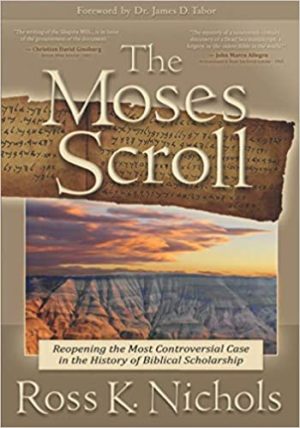
The best account of the entire Shapira story, from start to finish, was published by author and researcher Ross K. Nichols, just two weeks before Dershowitz published his own academic analysis. Nichols also includes a transcription and translation, as well as the arguments for revisiting the issue of their authenticity. He presents a meticulously researched, in-depth account of their discovery, as well as their examination by 19th century scholars, including a presentation of the arguments both for and against their authenticity. Entitled The Moses Scroll, the book is highly readable and engaging for scholars and non-scholars alike. Nichols has also begun a regular blog on all the latest Shapira discussions and issues.
__________________________________
*“The Case of Shapira’s Dead Sea (Deuteronomy) Scrolls of 1883.” Transactions of the Wisconsin Academy of Sciences, Arts and Letters (1958), p. 225
** Allegro, John Marco. The Shapira Affair. New York: Doubleday & Company, 1965
*** Shlomo Guil (2017) The Shapira Scroll was an Authentic Dead Sea Scroll, Palestine Exploration Quarterly, 149:1, 6-27, DOI: 10.1080/00310328.2016.1185895
****Idan Dershowitz, The Valediction of Moses: New Evidence on the Shapira Deuteronomy Fragments, Zeitschrift für die Alttestamentliche Wissenschaft, 2021. https://doi.org/10.1515/zaw-2021-0001
Cover Image, Top Left: The Wadi Mujib, in Jordan. F.Higer, Creative Commons Attribution-Share Alike 3.0 Unported license. Wikimedia Commons
___________________________
Advertisement



